
Sixty-five years since the first lunar farside imagesby Trevor Williams
|
| There were also various launch failures: Luna 2 was actually the sixth attempt to accomplish the mission. |
The spacecraft succeeded in taking 27 images simultaneously through a 200-millimeter wide-angle lens and a 500-millimeter narrow-angle lens. These images covered 70% of the far side and were of somewhat indifferent quality, but allowed the production of the first partial lunar farside atlas. High-contrast features, such as Mare Moscoviense (the dark spot at the upper right of the image above) and the crater Tsiolkovsky (the dark circle at the lower right with a central white dot), were identified and named from these images.
Luna 3 was the second spacecraft design in a sequence that Academician Mstislav Keldysh had proposed that the Soviets follow to explore the Moon [1, pp. 439-440], carried out under the guidance of the legendary Chief Designer Sergei Korolev. Spacecraft type Ye-1 was designed to impact the Moon, which was accomplished by Luna 2 on September 13, 1959. Luna 1, the first spacecraft to attempt this, had launched on January 2, 1959, but missed the Moon by 5,900 kilometers and became the first man-made object to enter heliocentric orbit. There were also various launch failures: Luna 2 was actually the sixth attempt to accomplish the mission.
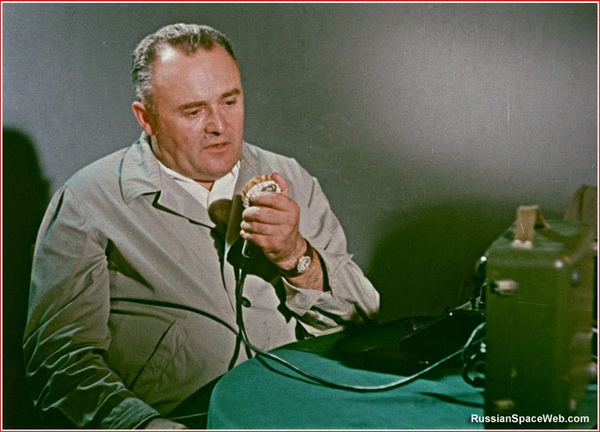 Sergei Korolev. (Credit: Russian Space Web) |
The Luna 3 mission to photograph the lunar far side was initially designated mission type Ye-2, although later changed to Ye-2a as a result of the various changes that had been made to it. A further mission type, Ye-3, was briefly under consideration: this would have involved detonating an atomic bomb on the Moon, producing a bright flash visible to observers around the Earth and giving irrefutable proof of a lunar impact. This was later dropped though, at least in part because of launch safety concerns. Subsequent mission types Ye-5 (obtaining higher-resolution images of the Moon) and Ye-6 (soft landing on the Moon) were accomplished by later missions in the 1960s.
To accomplish the early lunar missions, the kerosene/oxygen Blok-E upper stage was added to the Sputnik launcher, forming the Luna launch vehicle. This rocket was used nine times between September 1958 and April 1960, three of which were successful.
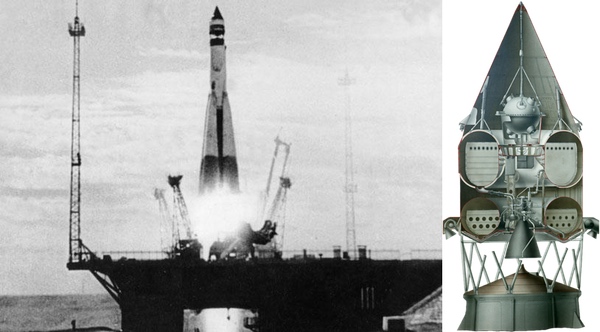 Luna 1 launch (left); Blok-E stage with Ye-1 spacecraft (right). (credits: Sovfoto/UIG and RIA Novosti, resp.) |
| The Soviets managed to retrieve usable film from some of the crashed US spy balloons; this was found to be suitable for Luna 3. |
The Luna 3 spacecraft had a mass of 279 kilograms and an internal pressure of 0.22 atmospheres. The basic shape was a cylinder 1.30 meters long and mainly 0.95 meters in diameter, increasing to 1.20 meters at a ring of solar cells: it was the first Soviet spacecraft to have solar cells as well as batteries. At one end it had a photoelectric cell that would detect the bright Moon, triggering the opening of doors covering the camera aperture. Other photocells were used as Sun sensors. It also had cold gas thrusters for attitude control: for most of the mission the spacecraft was spin stabilized, but it had to be three-axis stabilized when taking images. These thrusters did not allow changes in velocity, though, so the trajectory was completely determined by the performance of the launch vehicle. Luna 3 was the first Soviet spacecraft to be able to be three-axis-stabilized, although not the first of any spacecraft: the US Discoverer 1 did so in February 1959.
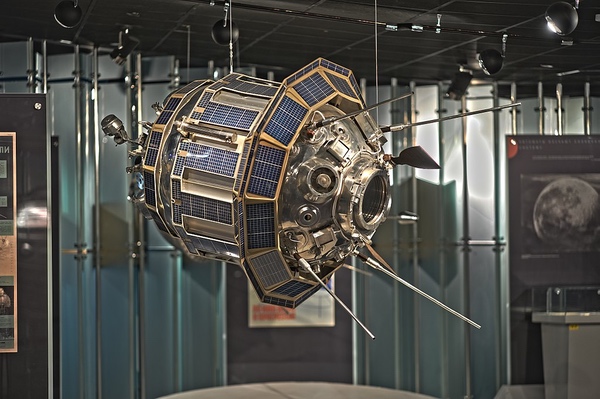 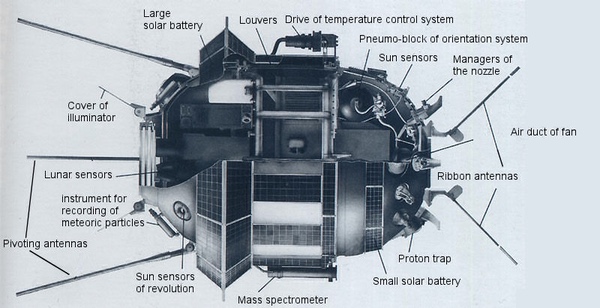 Luna 3 full size model (top; camera port doors on right end) and annotated layout (bottom). (dredits: Russian Cosmonautics Museum and Sven Grahn, resp.) |
A key component was of course the imaging system: as well as a camera first taking the photos, they then had to be developed onboard in what was jokingly referred to as the “bath and laundry” compartment [1, p. 532]. The resulting prints then had to be scanned, similar to in a fax machine, in order to be transmitted to Earth. Given the low transmitter power available on the spacecraft, this downlink had to take place when Luna 3 was at a somewhat low altitude, on the way down to perigee. Additional communication passes could also be attempted on subsequent orbits.
A major problem that was encountered while developing the Luna 3 imaging system was producing a film that would not become brittle from the cold of space or fogged by radiation and was sufficiently sensitive for the illumination conditions. Igor Lisochkin, the leader of the imaging group, had misgivings about the suitability of the “Type 17” aerial reconnaissance film that was then baselined for the mission [3]. Fortunately, help with this problem arose from an unexpected source: the USAF, US Navy, and CIA flew many spy balloons over the Soviet Union during the 1950s under Project GENETRIX (also referred to as WS-119L) [2]. Many of these crashed in the USSR or were shot down, particularly at night, when the cold air caused the balloons to descend. The Soviets managed to retrieve usable film from some of them; this was found to be suitable for Luna 3. There was a prohibition on using foreign equipment on Soviet spacecraft, so the source of this film was not advertised: it was simply referred to as film type ASh-1, which apparently is short for Americanski Sharik (ball or sphere) [3].
Luna 3 was launched from Baikonur at 00:43:40 UTC on October 4, 1959, and put into an orbit with apogee altitude 499,999 kilometers, i.e beyond the orbit of the Moon, and a period of 15 days. The trajectory was designed so as to not only give a close encounter with the Moon with geometry suitable for farside imaging, but also to use the gravity of the Moon to torque the orbit around so as to improve ground station visibility when it came time to downlink the processed images on the way down to perigee. In 1959, the only Soviet ground station available for deep space missions was in Crimea, at a latitude of around 45 degrees north, so the Moon was used to rotate perigee northwards. This gravity assist maneuver, using the gravity of another body to produce a desired change in the orbit of a spacecraft, was the first one ever performed.
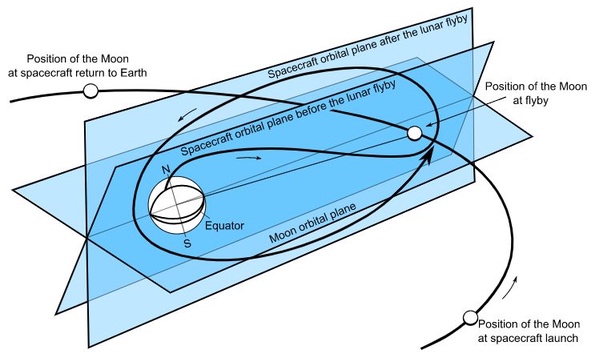 Luna 3 trajectory, showing effect of lunar gravity assist. (credit: Hiparick) |
Early in the mission there were difficulties with a weak downlink signal and spacecraft overheating [4], but urgent work by Korolev and his team managed to overcome these problems, partly by reorienting the spacecraft. The closest approach to the Moon occurred at 14:16 UTC on October 6 at a distance of 6,200 kilometers, and occurred prior to the start of imaging. Subsequently, the lunar photocell detector triggered opening of the camera doors, and the start of imaging occurred when “the spacecraft was located on a straight line between the Moon and the Sun” [1, p. 532]. A total of 29 images were taken, covering 70% of the far side, over a period of 40 minutes starting at 03:30 UTC October 7. The first image was taken at an altitude of 63,500 kilometers, and the final one at 66,700 kilometers. The photos were then developed onboard and downlinked as the spacecraft approached Earth: the signal strength was weak, but a total of either 12 or 17 images were eventually transmitted, probably on October 17 [4].
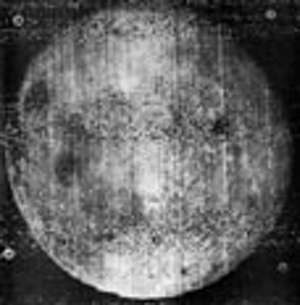 Luna 3 Image 35 (not cleaned up). (credit: Don Mitchell) |
While obtaining images of the far side of the Moon was a tremendous achievement, the team immediately recognized that certain modifications to a future mission could be made fairly readily that had the potential to significantly improve imaging quality. For instance, carrying out imaging when the spacecraft lies “on a straight line between the Moon and the Sun”, i.e. when the Moon is full as viewed by the spacecraft, had the advantage of ensuring that the entire visible hemisphere was illuminated, but the disadvantage that lunar topography would be washed out. Imaging from some other geometry would allow better views of the relief on the illuminated portion. Also, a ground receiver antenna with ten times the area of the one used for Luna-3 would shortly become available [1, pp. 534-535], increasing the signal-to-noise ratio of the downlink significantly. These changes, together with small modifications to the spacecraft, promised improved quality of lunar far side images in a future mission.
| Luna 3 had implications in the field of orbital mechanics, which makes sense given that it performed the first gravity assist. |
Two attempts were made to launch these missions, both of which unfortunately experienced launch vehicle failures. In the first, on April 15, 1960, the Blok-E stage burned out three seconds early, leaving the speed of the spacecraft 130 meters per second low. Somewhat incredibly, this was caused by the stage running out of kerosene early simply because the tank was not fully filled [1, p. 560]. The next attempt, on April 19, 1960, had a failure in one of the four booster stages: the vehicle reached an altitude of 200 meters and fell back near the pad, causing considerable damage. This prevented further Luna launches for several years, bringing to an end any hopes of further Luna 3-type reflights [1, p. 562].
Finally, Luna 3 had implications in the field of orbital mechanics, which makes sense given that it performed the first gravity assist. Describing, much less understanding, the behavior of a satellite that is acted upon by two massive bodies (the Three-Body Problem) is far more complicated than for a satellite orbiting a single body (the Two-Body Problem). Two researchers independently developed and published, both in 1962, a mathematical technique that can be used to address the Three-Body Problem under certain simplifying assumptions. Yoshide Kozai was a Japanese astronomer studying the orbital motion of asteroids, while Michail Lidov was a Russian orbital dynamicist who worked on many early Soviet spacecraft, notably Luna 3. (Lidov’s early papers were in Russian, and he was not able to travel to Paris to present his paper at the IUTAM Symposium in 1962.)
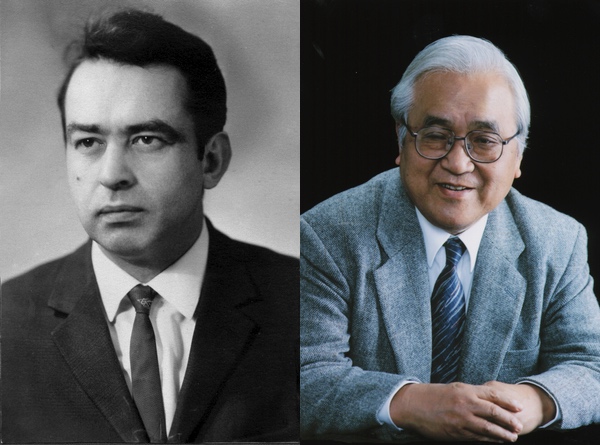 Michail Lidov (left); Yoshihide Kozai (right). (credits: www.keldysh.ru and IAU, resp.) |
Lidov’s analysis of the motion of Luna 3 in its high Earth orbit while the gravitational attraction of the Moon acted on it motivated his work that complemented very well the asteroid work of Kozai, ultimately leading to the technique that is now known as the Lidov-Kozai mechanism [5]. This approach has two significant application areas today: the study of an exoplanet orbiting a star that possesses another massive planet, and the long-term behavior of spacecraft in cislunar space. Both areas are currently of growing interest, so the influence of Luna 3 still lives on.
Note: we are now moderating comments. There will be a delay in posting comments and no guarantee that all submitted comments will be posted.